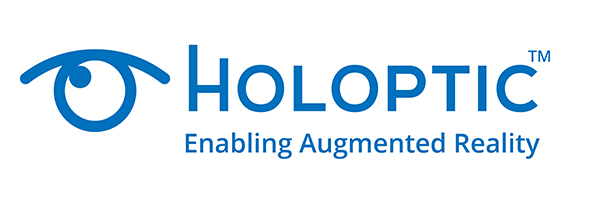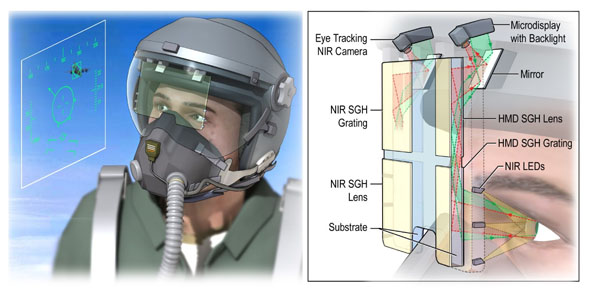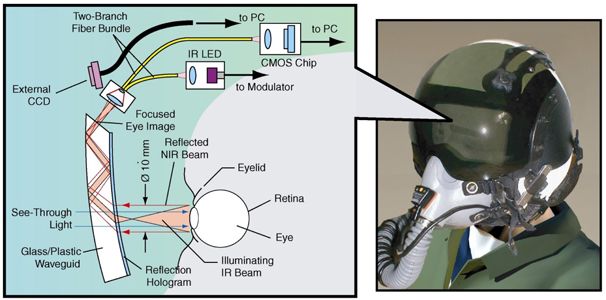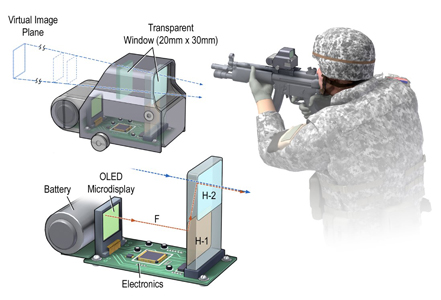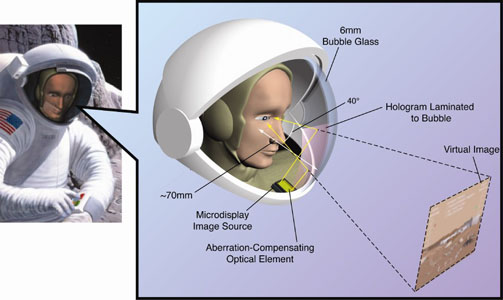Holoptic develops special-purpose HOEs for the Air Force, Army, Navy, and NASA as well as for consumer products such as LCD and LED televisions. With over 20 years of in-depth HOE expertise, we’ve made significant advances in HOE-based technology, and our holographic capabilities provide new HUD and HMD systems with display brightness that is 10 times higher than convention HOEs due to highly efficient holographic optical elements. Some of the benefits our customers experience include more efficient product design, larger virtual image size, reduced weight, more flexibility in packaging design, and reductions in power consumption due to increased efficiency.
Integrated Substrate-guided Wave-based Eyetracker and Helmet Mounted Display
Holoptic developed a new Integrated Substrate-guided wave (SGW) based Eye tracker and Head-Mounted Display that tracks the pilot’s eye position to enable a more precise targeting system that will lock in on targets based on pilot line of sight. The lightweight low-profile see-through display and its microprocessors are designed to fit within the pilot’s helmet with the joint helmet-mounted cueing system (JHMCS) visor without obstructing the pilot’s field of view.
Curved Wave-guided Holographic Display
Holoptic is developing a new Curved Wave-guided Holographic Display (CWHD) for pilot visors. This system is based on Luminit development of substrate-guided wave-based (SGW) holograms, guided beam direction, and waveguide radius. CWHD will be fabricated as a day/night HMD system that provides, at a minimum, binocular monochrome 1280×1024 imagery in a 40-degree FOV on a curved, transparent, holographic optical waveguide that is integrated into a visor. CWHD will be lightweight, show minimal aberration, and maximal brightness and image quality. It will be cost effective.
Wave-guided Holographic Infrared Soldier-Mounted Eye Tracker
Our Wave-guided Holographic Infrared Soldier-mounted Eye Tracker that can illuminate the eye with an infrared beam delivered from a set of NIR LEDs. Light reflected from the eye is coupled inside a thin plastic visor and diffracted to a high-speed camera. The information collected is processed in real time to determine the points of fixation of the eyes within milliseconds.
Dynamic Site Overlay Based on Luminit Substrate-guided Holographic Technology
Holoptic is developing a new high resolution, low cost and compact dynamic site overlay based on Luminit holographic technology. This system will present an optical system integrated into an individual soldier weapon-mounted direct-view optical scope satisfying MIL-STD-810 requirements to the military systems. DOSH will be fully see-through, have full color SXGA resolution or better with the brightness adjusted to the day and night illumination, not imposing significant cost and power increases to the sighting systems.
Substrate-guided wave-based Augmented Reality
Luminit developed a new cost-efficient wide FOV full-color see-through Substrate-guided wave based Augmented Reality Holographic Head Mounted Display that will significantly improve infantry training. This device will look like ballistic goggles and fit comfortably and stably on the head. Two >90% efficient color substrate-guided wave Bragg holographic optical elements form an image by passing it through the waveguide and directing it into the users line of sight to provide the augmented reality needed for situational training.
Lunar EVA Holographic Display
For NASA’s next generation EVA helmet design, Luminit developed a see-through, suit mounted holographic display that will provide vital information to the astronaut without obstructing vision. This hands free information display will be adjustable to provide maximum comfort for the astronaut.
Substrate Guided Holographic Diffuser as Efficient Backlighting Solution for LCDs and LED Lighting Application
Luminit developed a novel Substrate-Guided Holographic Diffuser for liquid crystal display (LCD) backlights and for light-emitting diode (LED) lighting that will reduce the power consumption of backlit LCDs, while making them more affordable to consumers. In this project, Luminit is reducing the number of optical components in LCD backlights and making them more efficient and bright with the application of a thin one-component bright LCD backlight that has a controlled output angular distribution. The increased efficiency reduces the power consumption.
